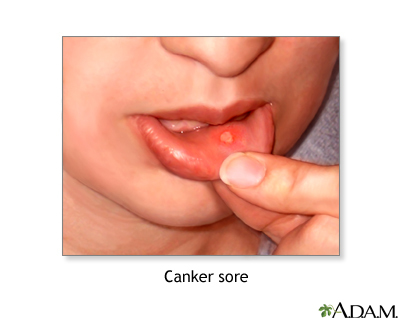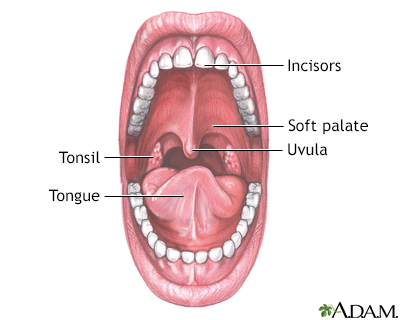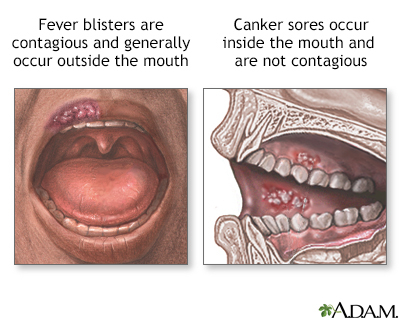Definition
A canker sore is a painful, open sore in the mouth. Canker sores are white or yellow and surrounded by a bright red area. They are not cancerous.
A canker sore is not the same as a fever blister (cold sore).
Alternative Names
Aphthous ulcer; Ulcer - aphthous
Causes
Canker sores are a common form of mouth ulcer. They may occur with viral infections. In some cases, the cause is unknown.
Canker sores may also be linked to problems with the body's immune system. The sores may also be brought on by:
- Mouth injury from dental work
- Cleaning the teeth too roughly
- Biting the tongue or cheek
Other things that can trigger canker sores include:
Anyone can develop a canker sore. Women are more likely to get them than men. Canker sores may run in families.
Symptoms
Canker sores most often appear on the inner surface of the cheeks and lips, tongue, upper surface of the mouth, and the base of the gums.
Symptoms include:
- One or more painful, red spots or bumps that develops into an open ulcer
- White or yellow center
- Small size (most often under one third inch or 1 centimeter across)
- Gray color as healing starts
Less common symptoms include:
Pain often goes away in 7 to 10 days. It can take 1 to 3 weeks for a canker sore to completely heal. Large ulcers can take longer to heal.
Exams and Tests
Your health care provider can often make the diagnosis by looking at the sore.
If canker sores persist or continue to return, tests should be done to look for other causes, such as erythema multiforme, drug allergies, herpes infection, and bullous lichen planus.
You may need further testing or a biopsy to look for other causes of mouth ulcers. Canker sores are not cancer and do not cause cancer. There are types of cancer, however, that may first appear as a mouth ulcer that does not heal.
Treatment
In most cases, the canker sores go away without treatment.
Try not to eat hot or spicy foods, which can cause pain.
Use over-the-counter medicines that ease pain in the area.
- Rinse your mouth with salt water or mild, over-the-counter mouthwashes. (DO NOT use mouthwashes that contain alcohol which can irritate the area more.)
- Apply a mixture of half hydrogen peroxide and half water directly to the sore using a cotton swab. Follow by dabbing a small amount of Milk of Magnesia on the canker sore afterward. Repeat these steps 3 to 4 times a day.
- Rinse your mouth with a mixture of half Milk of Magnesia and half Benadryl liquid allergy medicine. Swish mixture in the mouth for about 1 minute and then spit out.
- Over the counter numbing mouth rinses or drops can provide short term pain relief.
Medicines prescribed by your provider may be needed for severe cases. These may include:
- Chlorhexidine mouthwash
- Stronger medicines called corticosteroids that are placed on the sore or are taken in pill form
Brush your teeth twice a day and floss your teeth every day. Also, get routine dental check-ups.
In some cases, gastric acid-reducing medicines can decrease the discomfort.
Outlook (Prognosis)
Canker sores almost always heal on their own. The pain should decrease in a few days. Other symptoms disappear in 10 to 14 days.
References
Daniels TE, Jordan RC. Diseases of the mouth and salivary glands. In: Goldman L, Schafer AI, eds. Goldman-Cecil Medicine. 26th ed. Philadelphia, PA: Elsevier; 2020:chap 397.
Dhar V. Common lesions of the oral soft tissues. In: Kliegman RM, St. Geme JW, Blum NJ, Shah SS, Tasker RC, Wilson KM, eds. Nelson Textbook of Pediatrics. 21st ed. Philadelphia, PA: Elsevier; 2020:chap 341.
Klatt EC. Head and neck. In: Kumar V, Abbas AK, Aster JC, eds. Robbins and Cotran Atlas of Pathology. 10th ed. Philadelphia, PA: Elsevier; 2021:chap 6.



